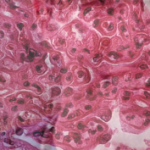As with many rheumatologic medications, the presence of NAFLD can complicate treatment options because of the concern for hepatotoxicity or the development of liver cirrhosis.
Dr. Barritt also discussed the rising rates of hepatitis C in the U.S. and pointed out that the Centers for Disease Control and Prevention now recommend universal screening among all U.S. adults.11 Luckily, if identified, nearly all patients with hepatitis C can be effectively treated with antiviral therapy and cured of the disease within 8–12 weeks with ledipasvir/sofosbuvir.
Dr. Barritt explained how hepatitis B infection can pose interesting problems for the rheumatologist. In patients with chronic hepatitis B infection, a significant risk exists of a potentially life-threatening flare of their disease if immunosuppressed, and these patients must receive suppressive therapy with an oral nucleotide or nucleoside agent, such as entecovir or tenofovir.
In a patient who has been exposed to hepatitis B but has cleared the infection, combination B and T cell immunosuppression can cause reverse seroconversion from hepatitis B surface antibody positivity to active hepatitis B infection with positive surface antigen.
Clinicians can identify these at-risk patients by making note of a positive hepatitis B core antibody in the patient’s lab testing. Although risk of reverse seroconversion is low with most rheumatologic medications, any patient being treated with B cell depleting therapy (i.e., rituximab) in combination with steroids should receive prophylaxis with entecovir or tenofovir, including for 12–18 months after the last rituximab dose.
Pregnancy & Rheumatic Disease
Megan Clowse, MD, MPH, associate professor of medicine in the Division of Rheumatology and Immunology at Duke University School of Medicine, Raleigh, N.C., provided a talk about pregnancy and rheumatic disease. The main focus of this lecture was the new guideline from the ACR on the management of reproductive health in rheumatic and musculoskeletal diseases.12 This guideline provides a thorough and extremely helpful framework clinicians can use to think about and understand reproductive issues in partnership with their patients.
Dr. Clowse pointed out that unplanned pregnancies are a major issue in many patients with rheumatologic diseases, and in patients with high-risk features of systemic lupus erythematosus (i.e., patients with highly active disease including nephritis, uncontrolled hypertension or untreated antiphospholipid syndrome), pregnancy loss can occur in up to 40% of cases and preterm birth can occur in up to 60–70% of cases.
With regard to pre-pregnancy communication goals, Dr. Clowse urges clinicians to be accurate in the information and guidance they provide and encourage the patient to be honest about their feelings and actions, thus allowing for effective collaboration. A simple opening question along the lines of “Do you have any plans to become pregnant?” can allow for a robust conversation between doctor and patient.


